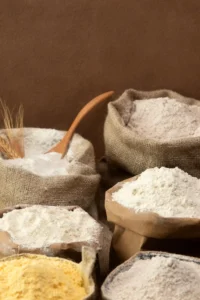This incredible Italian bread with its large, irregular holes and crunchy exterior is absolutely delicious and might just become your new favorite bread! But hold on, are you familiar with the story behind its inventions? Or how to say its name like an Italian would? Don’t fret. In this article, you’ll discover everything you should know about ciabatta bread! from its history and origins to its various uses and varieties and more.

What is Ciabatta Bread?
Ciabatta is a light and airy Italian bread made from a highly hydrated leavened dough, characterized by a crisp, chewy crust and a unique, open crumb structure. Ciabatta’s dough typically consists of basic bread ingredients: wheat flour, water, salt, and a leavening agent, which may vary based on the baker’s preferences but often includes one of the pre-ferments like Biga, Poolish, or Lievito Madre. The “ciabatta” comes from the Italian term “la ciabatta,” which translates to “slipper”, perfectly describing its elongated, slightly flattened shape reminiscent of a slipper.
How do you Pronounce Ciabatta?
Ciabatta is literally pronounced “cha-BAH-ta”, but the way it is articulated can differ globally based on native languages and their pronunciation of letters. For instance, the French pronounce it as “tsha-ba-ta”, Americans often say “chuh-baa-tuh”, whereas British speakers typically say “chuh-ba-tuh”.
History and Origins
In the early 1980s, traditional Italian bread was losing ground to the popularity of the baguette, which sparked a new idea: create a better bread than the famous French baguette. After several weeks of testing various recipe formulas, Arnaldo Cavallari chose to develop a high hydration dough using high-gluten flour; incorporating the same ingredients as those found in baguettes but utilizing traditional Italian preferments.
Quickly, ciabatta has gained popularity throughout Italy and beyond, where both bakers and connoisseurs alike appreciate its crisp crust, irregular holes, and slightly tangy flavor. Ciabatta was introduced to the UK in 1985 by Marks & Spencer and to the US in 1987 by Orlando Bakery, and by 1999, Arnaldo had licensed bakers in 11 countries to produce ciabatta. By 1999, Arnaldo had granted licenses to bakers in 11 countries to produce ciabatta.
What Make Ciabatta Bread Special?
Traditional Ciabatta is notable for several key features:
- Distinctive texture: An irregular, open and airy crumb texture, with a crispy, chewy, golden crust, thanks to the use of a highly hydrated dough and a slow fermentation process.
- Flavor simplicity: Ciabatta usually has a mild yet tangy flavor, but its exact flavor can vary depending on the leavening agents used and the duration of the fermentation.
- Unique Shape: Unlike other types of bread, ciabatta has a long, irregular shape and a rustic look, making it visually appealing and versatile for various uses.
Is Ciabatta Healthy?
To clarify, the exact answer to this question changes based on the ingredients utilized, particularly the leavening agents. If you are consuming ciabatta made from lievito madre bread, it can be said to offer the same benefits of sourdough bread, as lievito madre is created with the same ingredients and follows a similar production process. However, if the ciabatta is made with different leavening agents, it possesses the same qualities as regular white bread.
Does Ciabatta have Gluten?
As long as the ciabatta is made from wheat flour, it is not gluten-free. However, if you have a gluten allergy and are still want to enjoy a slice of ciabatta, You are lucky: gluten-free versions of ciabatta are available.
Ciabatta Variations
Even though it’s made from a different types of preferments, ciabatta doesn’t have a wide range of varieties, which is somewhat reasonable given the bread’s relatively recent origin. However, because of the high demand for ciabatta, bakers have chosen to create different recipes for it to satisfy consumer demand, along with a few regional variations that are specific to certain areas of Italy, particularly:
- Classic ciabatta: Made from Bread flour, water, salt, yeast, and occasionally olive oil. Some Italian bakers use a combination of semolina and bread flour in their recipes.
- Whole wheat ciabatta: Prepared with whole wheat flour instead of bread flour, offering better nutritional benefits than the classic kind, while still maintaining the characteristic crisp crust and airy, chewy texture filled with holes.
- Ciabatta al latte (Milk ciabatta): As its name suggests, this ciabatta is made with a dough that incorporates milk instead of water, resulting in a softer bread with a tender crumb.
- Lake Como ciabatta: Typically, this type has a softer, lighter texture and is less airy than the traditional version. It is usually made with a biga starter and features a similarly crispy crust.
- Tuscan ciabatta: Often has a robust crust and dense crumb, reflecting the traditional baking methods of the region.
- Romain ciabatta: Just like focaccia, Romain ciabatta is frequently seasoned with olive oil and marjoram.

What is Ciabatta Bread Mainly used For?
Ciabatta is a bread loaf that complements a wide variety of dishes, from classic Italian bruschetta and filling sandwiches to tasty paninis, nutritious toppings, and rich dips and cheeses. But who better to ask about the ideal way to enjoy this white bread than Marco Vianello, the close friend of Arnaldo Cavallari? Where he says, “If you’re a young child, you might want to spread it with chocolate Nutella. But for me, bacon, ham, or even mortadella are fantastic pairings. And don’t overlook its role as a perfect sidekick to pasta with sauce, where you can clean the pasta dish with it”.




